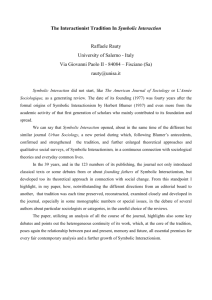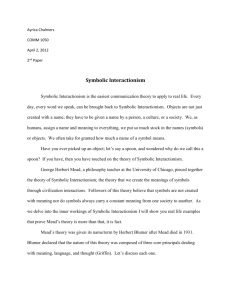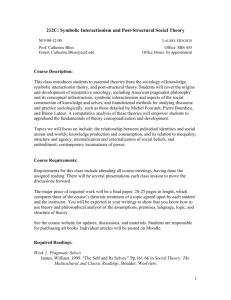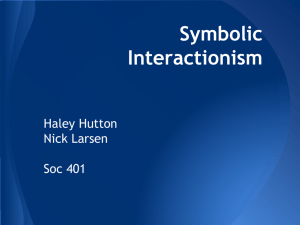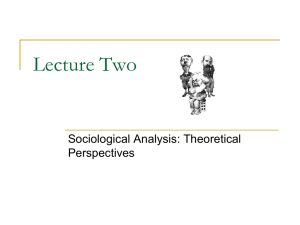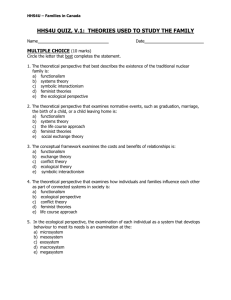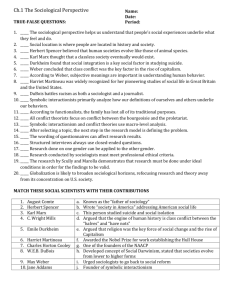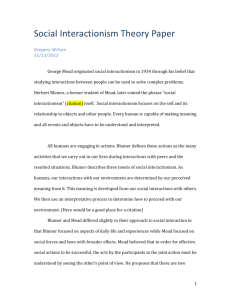Comm. Theory – Symbolic Interactionism Report
advertisement
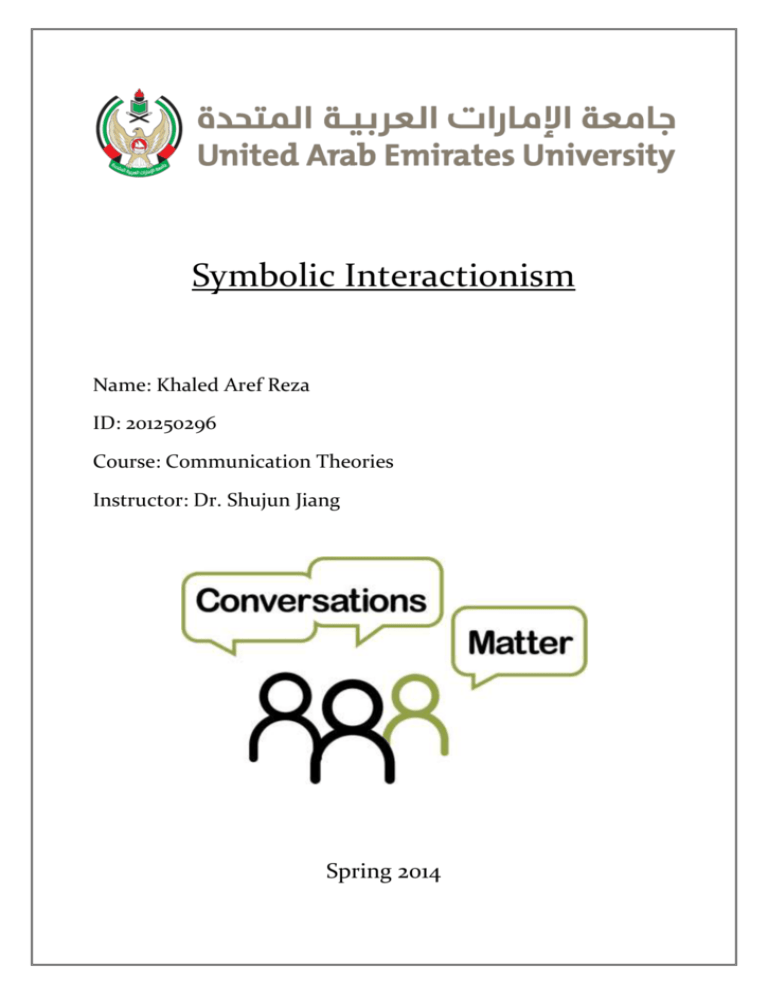
Symbolic Interactionism Name: Khaled Aref Reza ID: 201250296 Course: Communication Theories Instructor: Dr. Shujun Jiang Spring 2014 Symbolic Interactionism One of the many theories in the world of communication is ‘Symbolic Interactionism’. Simply put, it is a framework of the sociological theory, which means it can live as long as the social factor is not kept out of its presence. It relies on the symbolic meaning that people develop and rely upon in the process of social interaction, and hence, it is a theory that was born as a result of human interaction and how meaning could be given to different things using language as a means. I shall speak more of that later. Throughout the ages, the name George Herbert Mead has been heard quite frequently, particularly in the fields of philosophy and communication. Mead was a Philosophy professor at the University of Chicago in the United States, and he was the founder of the concept of the Symbolic Interactionism theory. He did not, however, give the name of the theory. It was simply a concept which was later named ‘Symbolic Interactionism’ by his very own student, Herbert Blumer. Also, after his passing away, a book titled ‘Mind, Self and Society’ was published in his name by his students. Mead had three principles that could very well sum up the theory. One of these was ‘Humans act toward things on the basis of the meanings they ascribe to those things’. This clearly means that us humans always have a reaction towards an event, occurrence or even certain things, all based on the meaning that we have given to those things. The other principle states that ‘The meaning of such things is derived from, or arises out of, the social interaction that one has with others and the society’. I for one think that this is the clearest principle in the definition of Symbolic Interactionism. Meaning cannot be given to anything just by one person alone. It would simply be an exercise in futility. The true meaning of the things arises and only arises when one has social interactions with the wider society. If I call an apple a pomme, it only has that meaning for me. If with socializing and consulting and interaction we give meaning to the apple, we call it an apple and consider it a source of food and everyone can comprehend the true value of the thing. The last principle that was said by Mead is ‘These meanings are handled in, and modified through, an interpretative process used by the person in dealing with the things he or she encounters’. This is more in regards to the distinction of humans and other living things. Human beings have the power of thought and understanding, and of course the ability to improvise on things as they see fit. The student of George Mead, that is Herbert Blumer, mentioned a quote that I personally find very true and cohesive with the concept of Symbolic Interactionism. This is the quote: “Communication is the most human and humanizing activities in which people are engaged.” It is so true that there is nothing that could confirm humanization more than communication. We humans are animals as well, but we have been blessed with certain powers that distinguish us from other forms of life. These powers are meaning, language and thought. Meaning, language and thought The world is filled with myriad languages of all types that facilitate a wide range of communication. There are a lot of differences between each language, especially for when it comes to how it was created, how it is used and what it is used for. What is common between all languages is that they are all comprised of symbolic representations of concepts and are all used for communication. On a daily basis, we communicate though sounds, gestures, written text and other means. We all have experiences both in starting a communication and in perceiving communication that began with others. Perhaps you, who are reading this, have the experience of understanding the meaning of what you are reading, or at least have to think that you likely have some understanding of it. Everyone has certainly come across situations where they did not understand the meaning of a certain written passage or a certain word made by another. So therefore it makes sense that everyone who is capable of using language at different times has both the experience of understanding the meaning of certain things and of misunderstanding certain other things. This then leads to the general question of what exactly is meaning and how one can come to understand the meaning of symbols, words, expressions etc. The three powers that were mentioned earlier, which were meaning, language and thought are quite simple to explain. Meaning can be understood as the assigned explanations toward things and or people and how to act toward it. Language is the method or the means by which Meaning is expressed. We can say that language is the carrier of meaning in some sense. And finally, thought. The interpretation of meanings based on one’s thought process is probably the best description of this particular principle. Together, these three principles underline the significance of how meaning is given and assigned and shared and expressed, all with the help of socialization and interaction. A perfect example to further elaborate the concept of Symbolic Interactionism is that of youth who smoke. Picture a bunch of teenagers who have nothing to worry about in life, but simply smoke a dozen cigarettes every now and then. Here’s the catch. They know that cigarettes kill and they are well aware that it has ill effects for their body. But they think of it as something cool. They think it projects them well to their peers and makes them look impressive and very macho. And therefore, the Meaning that the youth have assigned to smoking with their peers about it being something cool is overlapping the actual facts about smoking. The Self Another important factor that is built through interaction is ‘The Self’. Self is a social emergent, and are the products of social interaction and not the logical or biological preconditions of an interaction, with capacity that is built through language, play and game, or more commonly known as ‘role-play’. This is usually quite frequently seen in younger children. Mingling in a society or a community is absolutely vital in the finding of one’s true self. It is only then that we can find a basis for our own improvement and self judgement, through the eyes of others. This is also known as the looking-glass self. The five central ideas There are five ideas that lie behind the Symbolic Interactionism theory that I will describe very briefly. These are: The human being must be understood as a social person The human being must be understood as a thinking being Humans do not sense their environment directly, instead, humans define the situation they are in The cause of human action is the result of what is occurring in our present situation Human beings are described as active beings in relation to their environment Of course, human beings are social animals with an incredible power of thought. These two are more than enough in marking a clear separation between us and anything else. Other than the fact that it is merely a distinction, it is a tool for survival. Humans MUST socialize and think in order to survive. Animals usually act and react based on their power of instinct. Humans think and react based on their power of thought. We do not simply take in what we see in front of our eyes, but rather we think about it and try to define everything that we see. What we decide to do is directly linked to the present moment, meaning actions are made depending on what’s best for the current situation and not for what the instinct says. We are active and moving, and we are social beings who interact with one other for survival. Criticism on Symbolic Interactionism Like everything else in life, even this theory has not been spared of criticism. A few of them that I have found to be true myself, are found below. Symbolic Interactionists are overly impressionistic in their research methods and unsystematic in their theories. Also, the theory of Symbolic Interactionism is not one theory but it is also the framework for many different theories, thus making it a very wide subject which normally leads to confusion. Experts often may miss the larger issues of society by focusing too closely on the “trees” rather than the “forest”. This of course is a metaphorical statement for focussing too much on one particular topic that might not be of true significance. The movie ‘Nell’ As the topic of Symbolic Interactionism was very closely related to the movie ‘Nell’, I decided to speak about it briefly as well. Since there isn’t much difference in what I said in my previous works and what I am about to say now, a lot of similarities can be found between them. Anyways, this is the brief story of Nell. Nell was a hermit who lived far away from civilization. Her only company was her mother and twin sister, who died at a young age. Since Nell’s mother suffered a stroke and used the language of the bible in her usual communication, most of Nell’s speech is unrecognizable. One wouldn’t expect her to speak any clearer because that is all that she was exposed to all day long! Moreover, the looking-glass self image is absent, and that is one aspect that Nell’s speech remained unclear. She thought that the way her mother spoke was the way to go, oblivious of the world outside! This is also seen in our day to day lives, but not to the extent of Nell. Students who attend an Indian school tend to end up with a strong Indian accent whereas those who grow up around American people end up with a clear command of English. This happens on a small scale, on the basis of being surrounded and exposed to such influences for a long period of time. The giving of meaning was very elaborate in the movie. Nell decided that Jerry was her guardian angel because he didn’t give up on her and kept communicating with her. The source of meaning is the language and in the movie, when Paula realizes that Nell has a large amount of vocabulary that she actually uses to communicate with –albeit difficult to comprehend- she assumes that she isn’t stupid. The thought process was also very nicely explained in the film. The thought demands a person to think and respond based on made decisions, and not on mere instinct like animals. And it seemed like in the movie, Paula and Jerry were expecting a mere reaction from Nell rather than a response. But they learnt that after a few interactions, the scope of her thinking is actually acceptable and is able to be improved. Hence, meaning, language and thought are strictly interconnected. The issue of self is one that was shown in the movie when Nell sat before the mirror and with constant hand gestures and hugs repeated the words May and Tay, Me and I respectively. This confirmed her humanity and the fact that she had a self that was intact and sane. If Nell were to survive or even comprehend living in a community, she needs to find out what they do, what their actions mean and what they expect from her as an individual. In other words, she needs to look at herself from their point of view. References: www.google.com http://www.youtube.com/watch?v=jFQIIM8IRZU http://sociology.about.com/od/Sociological-Theory/a/Symbolic-InteractionTheory.htm http://en.wikipedia.org/wiki/Symbolic_interactionism http://sociology.about.com/od/Profiles/p/George-Herbert-Mead.htm http://enlightenedworldview.com/blog/?title=language-thought-andmeaning&more=1&c=1&tb=1&pb=1 The first essay that I submitted
